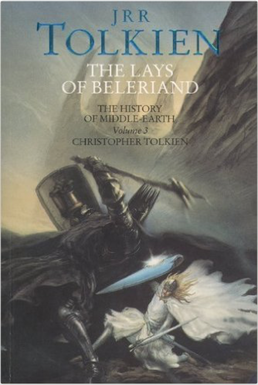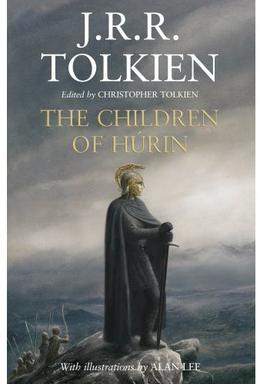Eärendil the Mariner and his wife Elwing are characters in J. R. R. Tolkien's Middle-earth legendarium. They are depicted in The Silmarillion as Half-elven, the children of Men and Elves. He is a great seafarer who, on his brow, carried the Morning Star, a jewel called a Silmaril, across the sky. The jewel had been saved by Elwing from the destruction of the Havens of Sirion. The Morning Star and the Silmarils are elements of the symbolism of light, for divine creativity, continually splintered as history progresses. Tolkien took Eärendil's name from the Old English name Earendel, found in the poem Crist I, which hailed him as "brightest of angels"; this was the beginning of Tolkien's Middle-earth mythology. Elwing is the granddaughter of Lúthien and Beren, and is descended from Melian the Maia, while Earendil is the son of Tuor and Idril. Through their progeny, Eärendil and Elwing became the ancestors of the Númenorean, and later Dúnedain, royal bloodline.
A Balrog is a powerful demonic monster in J. R. R. Tolkien's Middle-earth. One first appeared in print in his high-fantasy novel The Lord of the Rings, where the Fellowship of the Ring encounter a Balrog known as Durin's Bane in the Mines of Moria. Balrogs appear also in Tolkien's The Silmarillion and his legendarium. Balrogs are tall and menacing beings who can shroud themselves in fire, darkness, and shadow. They are armed with fiery whips "of many thongs", and occasionally use long swords.
In the works of J. R. R. Tolkien, the Noldor are a kindred of Elves who migrate west to the blessed realm of Valinor from the continent of Middle-earth, splitting from other groups of Elves as they went. They then settle in the coastal region of Eldamar. The Dark Lord Morgoth murders their first leader, Finwë. The majority of the Noldor, led by Finwë's eldest son Fëanor, then return to Beleriand in the northwest of Middle-earth. This makes them the only group to return and then play a major role in Middle-earth's history; much of The Silmarillion is about their actions. They are the second clan of the Elves in both order and size, the other clans being the Vanyar and the Teleri.
Finwë and Míriel are fictional characters from J. R. R. Tolkien's legendarium. Finwë is the first King of the Noldor Elves; he leads his people on the journey from Middle-earth to Valinor in the blessed realm of Aman. His first wife is Míriel, who, uniquely among immortal Elves, dies while giving birth to their only child Fëanor, creator of the Silmarils; her spirit later serves the godlike Vala queen Vairë. Finwë is the first person to be murdered in Valinor: he is killed by the Dark Lord Morgoth, who is intent on stealing the Silmarils. The event sets off the Flight of the Noldor from Valinor back to Beleriand in Middle-earth, and its disastrous consequences.

Fëanor is a fictional character in J. R. R. Tolkien's The Silmarillion. He creates the Tengwar script, the palantír seeing-stones, and the three Silmarils, the skilfully-forged jewels that give the book their name and theme, triggering division and destruction. He is the eldest son of Finwë, the King of the Noldor Elves, and his first wife Míriel.
Gil-galad is a fictional character in J. R. R. Tolkien's Middle-earth legendarium, the last high king of the Noldor, one of the main divisions of Elves. He is mentioned in The Lord of the Rings, where the hobbit Sam Gamgee recites a fragment of a poem about him, and The Silmarillion. In the Last Alliance of Elves and Men, Gil-galad and Elendil laid siege to the Dark Lord Sauron's fortress of Barad-dûr, and fought him hand-to-hand for the One Ring. Both Gil-galad and Elendil were killed, and Elendil's son Isildur took the Ring for himself. Gil-galad briefly appears at the opening of Peter Jackson's The Lord of the Rings film trilogy, and in several video games based on Tolkien's Middle-earth.

Elu Thingol or Elwë Singollo is a fictional character in J.R.R. Tolkien's Middle-earth legendarium. He appears in The Silmarillion, The Lays of Beleriand and The Children of Húrin and in numerous stories in The History of Middle-earth. The King of Doriath, King of the Sindar Elves, High-king and Lord of Beleriand, he is a major character in the First Age of Middle-earth and an essential part of the ancestral backgrounding of the romance between Aragorn and Arwen in The Lord of the Rings. Alone among the Elves, he married an angelic Maia, Melian.

Fingolfin is a character in J. R. R. Tolkien's legendarium, appearing in The Silmarillion. He was the son of Finwë, High King of the Noldor. He was threatened by his half-brother Fëanor, who held him in contempt for not being a pure-bred Noldor. Even so, when Fëanor stole ships and left Aman, Fingolfin chose to follow him back to Middle-earth, taking the dangerous route over the ice of the Helcaraxë. On arrival, he challenged the Dark Lord Morgoth at the gates of his fortress, Angband, but Morgoth stayed inside. When his son Fingon rescued Maedhros, son of Fëanor, Maedhros gratefully renounced his claim to kingship, and Fingolfin became High King of the Noldor. He was victorious at the battle of Dagor Aglareb, and there was peace for some 400 years until Morgoth broke out and destroyed Beleriand in the Dagor Bragollach. Fingolfin, receiving false news, rode alone to Angband and challenged Morgoth to single combat. He wounded Morgoth several times, but grew weary and was killed by the immortal Vala.

Blind Guardian is a German power metal band formed in 1984 in Krefeld, West Germany. They are often credited as one of the seminal and most influential bands in the power metal and speed metal subgenres. Nine musicians have been a part of the band's line-up in its history, which currently consists of singer Hansi Kürsch, guitarists André Olbrich and Marcus Siepen and, since 2005, drummer Frederik Ehmke.
Tuor Eladar and Idril Celebrindal are fictional characters from J. R. R. Tolkien's Middle-earth legendarium. They are the parents of Eärendil the Mariner and grandparents of Elrond Half-elven: through their progeny, they become the ancestors of the Númenóreans and of the King of the Reunited Kingdom Aragorn Elessar. Both characters play a pivotal role in The Fall of Gondolin, one of Tolkien's earliest stories; it formed the basis for a section in his later work, The Silmarillion, and was expanded as a standalone publication in 2018.

The Lays of Beleriand, published in 1985, is the third volume of Christopher Tolkien's 12-volume book series, The History of Middle-earth, in which he analyzes the unpublished manuscripts of his father J. R. R. Tolkien.
The term Middle-earth canon, also called Tolkien's canon, is used for the published writings of J. R. R. Tolkien regarding Middle-earth as a whole. The term is also used in Tolkien fandom to promote, discuss and debate the idea of a consistent fictional canon within a given subset of Tolkien's writings.

Live is the second live album by German power metal band Blind Guardian. It was recorded during the Blind Guardian World Tour 2002/2003 in Tokyo, Stockholm, Lichtenfels, Venice, Düsseldorf, Milan, Florence, Barcelona, San Sebastián, Avilés, Madrid, Granada, Valencia, Bremen, Moscow, Hamburg, Berlin, Munich, Stuttgart.

Beren and Lúthien is a 2017 compilation of multiple versions of the epic fantasy Lúthien and Beren by J. R. R. Tolkien, one of Tolkien's earliest tales of Middle-earth. It is edited by Christopher Tolkien. It is the story of the love and adventures of the mortal Man Beren and the immortal Elf-maiden Lúthien. Tolkien wrote several versions of their story, the last in The Silmarillion, and the tale is also mentioned in The Lord of the Rings at the council of Elrond. The story takes place during the First Age of Middle-earth, about 6,500 years before the events of The Hobbit and The Lord of the Rings.

The Children of Húrin is an epic fantasy novel which forms the completion of a tale by J. R. R. Tolkien. He wrote the original version of the story in the late 1910s, revising it several times later, but did not complete it before his death in 1973. His son, Christopher Tolkien, edited the manuscripts to form a consistent narrative, and published it in 2007 as an independent work. The book is illustrated by Alan Lee. The story is one of three "Great Tales" set in the First Age of Tolkien's Middle-earth, the other two being Beren and Lúthien and The Fall of Gondolin.
Morgoth Bauglir is a character, one of the godlike Valar, from Tolkien's legendarium. He is the primary antagonist of Tolkien's legendarium, the mythic epic published in parts as The Silmarillion, The Children of Húrin, Beren and Lúthien, and The Fall of Gondolin.
The Silmarils are three fictional brilliant jewels in J. R. R. Tolkien's legendarium, made by the Elf Fëanor, capturing the unmarred light of the Two Trees of Valinor. The Silmarils play a central role in Tolkien's book The Silmarillion, which tells of the creation of Eä and the beginning of Elves, Dwarves and Men.

The Silmarillion is a book consisting of a collection of myths and stories in varying styles by the English writer J. R. R. Tolkien. It was edited, partly written, and published posthumously by his son Christopher Tolkien in 1977, assisted by Guy Gavriel Kay, who became a fantasy author. It tells of Eä, a fictional universe that includes the Blessed Realm of Valinor, the ill-fated region of Beleriand, the island of Númenor, and the continent of Middle-earth, where Tolkien's most popular works—The Hobbit and The Lord of the Rings—are set. After the success of The Hobbit, Tolkien's publisher, Stanley Unwin, requested a sequel, and Tolkien offered a draft of the writings that would later become The Silmarillion. Unwin rejected this proposal, calling the draft obscure and "too Celtic", so Tolkien began working on a new story that eventually became The Lord of the Rings.

Beyond the Red Mirror is the tenth studio album by the German power metal band Blind Guardian, released on 30 January 2015 through Nuclear Blast.









